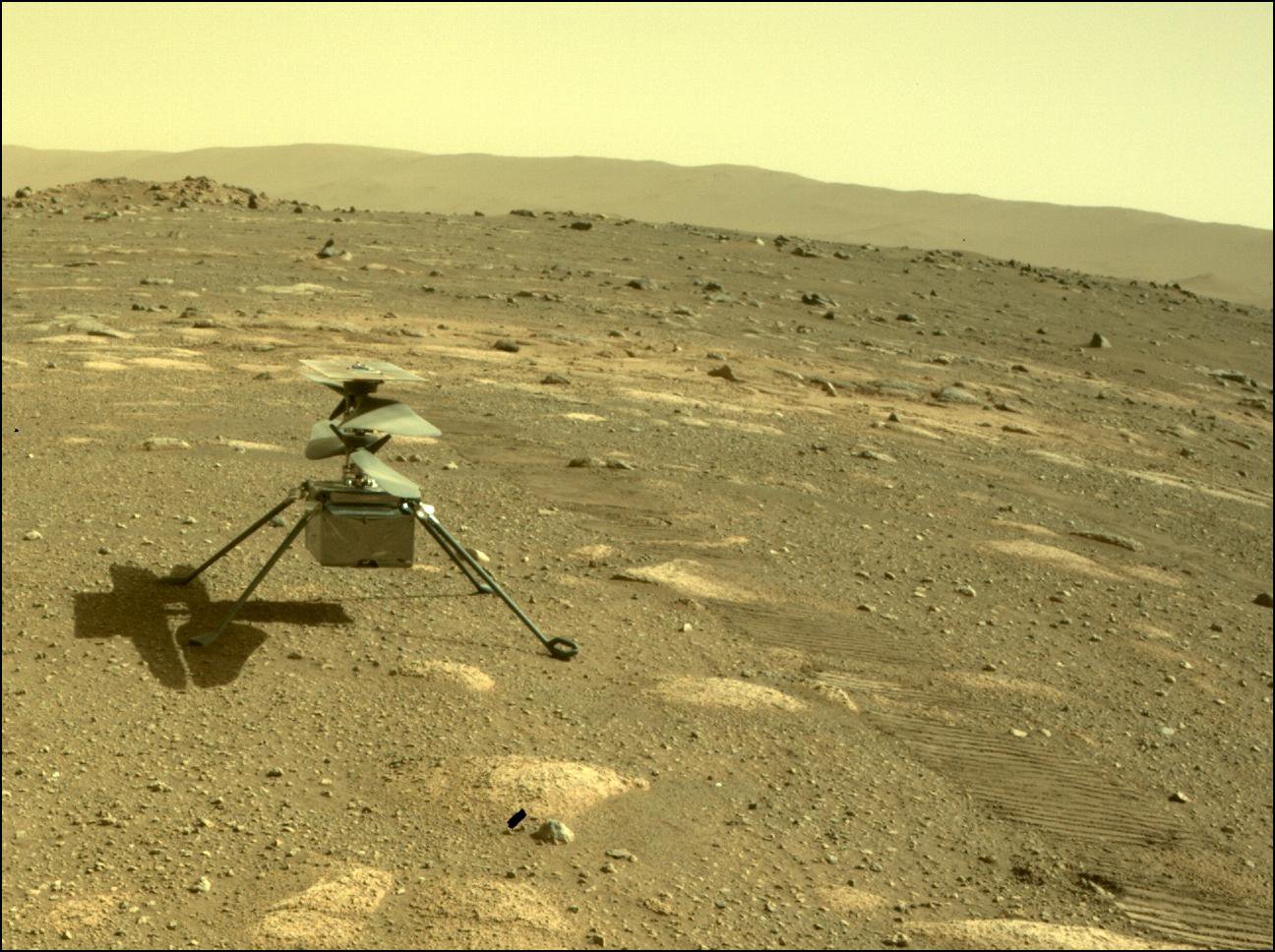Mars helicopter Ingenuity recovering from communications blackout spawned by dust
The drone is back in contact and NASA's Jet Propulsion Laboratory hopes to return it to normal operations soon.

NASA's Mars helicopter Ingenuity appears to be in recovery from a communications glitch on Mars.
The agency's Jet Propulsion Laboratory (JPL) reestablished contact with the small Ingenuity chopper on Thursday (May 5) after it missed a scheduled call-in about two days before, the agency reported Friday (May 6).
Engineers suggest that the Mars helicopter may have entered a low power state due to a combination of high levels of dust in the atmosphere and low local temperatures. The situation rendered the solar-powered Ingenuity unable to communicate with its base station, the Perseverance rover, which sends the helicopter's status to Earth via Martian satellite.
"The dust diminishes the amount of sunlight hitting the solar array, reducing Ingenuity's ability to recharge its six lithium-ion batteries," JPL continued. "When the battery pack's state of charge dropped below a lower limit, the helicopter's field-programmable gate array (FPGA) was powered down."
Related: 1 year later, Ingenuity helicopter still going strong on Mars
Ingenuity was recently approved to fly through at least September, and has now racked up 28 sorties. That's considerably beyond its initial flight plan, of five excursions planned after it landed on the Martian surface in February 2021, along with Perseverance. Ingenuity's rotor revolutions per flight were increased last September to account for lessening atmospheric density due to seasonal changes at the mission's landing area, Mars' Jezero Crater.
So far the plan has worked well. The rotorcraft has racked up a total of 4.2 miles (6.9 kilometers) of flight distance and is now serving as a scout for Perseverance activities as the mission enters an ancient delta in search of potential signs of Martian life. Recently, the mini-helicopter even snapped valuable photos of Perseverance's discarded landing system to help spacecraft engineers plan future missions.
Breaking space news, the latest updates on rocket launches, skywatching events and more!
But the helicopter is battling dust, seasonal changes and conditions beyond its design plan, all of which mean it will face more obstacles in continuing its flights in the coming months.
The FGPA unit is crucial to making sure Ingenuity remains operational, including controlling the power to avionics elements and operating heaters to keep Ingenuity alive during cold Martian nights. It is also responsible for the spacecraft's time-keeping, including for scheduled calls with Perseverance.
Controllers suspect that after the FGPA lost power, which happened during a Martian night, the helicopter's clock reset and the heaters turned off.
"When the sun rose the next morning and the solar array began to charge the batteries, the helicopter's clock was no longer in sync with the clock aboard the rover," JPL stated. "Essentially, when Ingenuity thought it was time to contact Perseverance, the rover's base station wasn’t listening."
To try to catch Ingenuity again, engineers commanded Perseverance to listen for the signal for nearly an entire Martian sol (day) on May 5, and finally heard from the helicopter around 11:45 a.m. local Mars time. Ingenuity was limited in what it could send to preserve its power, but controllers were able to determine that the helicopter's basic health appeared to be good.
"The radio link between Ingenuity and Perseverance was stable, spacecraft temperatures were within expectation, the solar array was recharging the battery at a rate expected for this season, and the battery was healthy, containing 41% of a full charge," JPL stated.
Dust, however, will remain a persistent threat for the solar-powered mission and make it more difficult to recharge the batteries to maintain the vital heaters and the clock through the frigid overnight. JPL officials said that Ingenuity has turned on its heaters whenever battery temperatures were lower than 5 degrees Fahrenheit (minus 15 degrees Celsius) for the past three sols. (A Martian sol is about 40 minutes longer than an Earth day.) However, engineers worry that if this approach continues, the battery will be unable to keep the heaters going throughout the night.
Engineers now have a new plan. As of last week, a new set of commands changed the point at which the battery turns on, to minus 40 degrees F (minus 40 degrees C). The helicopter will also be tasked to shut down immediately, instead of using up "precious" battery charge, JPL stated.
"The team hopes this strategy will allow the battery to retain whatever charge it collected during the day. The Ingenuity engineers hope that after several days of the helicopter's array soaking in the limited rays, the battery will have reached a point where the spacecraft can return to normal operations," JPL said.
The risk is that Ingenuity carries with it commercial off-the-shelf parts not optimized to stay active in the profound cold of Mars, estimated at minus 112 degrees F (minus 80 degrees C) at Ingenuity's location. So JPL struck a note of caution while saying engineers are hopeful they will maintain more battery energy (and communications) for at least a few more Earth weeks.
"We have always known that Martian winter and dust storm season would present new challenges for Ingenuity, specifically colder sols, an increase in atmospheric dust, and more frequent dust storms," Teddy Tzanetos, Ingenuity team lead at JPL, said in the same statement. "Every flight and every mile of distance flown beyond our original 30-sol mission has pushed the spacecraft to its limits each and every sol on Mars."
Follow Elizabeth Howell on Twitter @howellspace. Follow us on Twitter @Spacedotcom or Facebook.

Elizabeth Howell (she/her), Ph.D., was a staff writer in the spaceflight channel between 2022 and 2024 specializing in Canadian space news. She was contributing writer for Space.com for 10 years from 2012 to 2024. Elizabeth's reporting includes multiple exclusives with the White House, leading world coverage about a lost-and-found space tomato on the International Space Station, witnessing five human spaceflight launches on two continents, flying parabolic, working inside a spacesuit, and participating in a simulated Mars mission. Her latest book, "Why Am I Taller?" (ECW Press, 2022) is co-written with astronaut Dave Williams.

